



REGGAE & SKA:
I am still searching for verified histories of these two beat patterns. Meanwhile, I'll just pass along what I have picked up over the years.
Legend has it that Ska came first from Europe during the early days of the British rock and pop invasions of the 1960s. Actually, classic
Reggae and Ska are based on the same general beat patterns. Some have theorized that both music styles were the
result of a drummer with a coordination problem. It is only speculation, though it appears as if the original drummer may have had problems
playing all the hi-hat notes in a bar of 8th 4/4. later that drummer became extremely proficient at playing the cymbal only on the 'and or +'. As a result,
the other rhythm instruments in the band picked-up on the different 'feel' of the rhythms, then followed the drummer. Completely new and
different music styles emerged. It exemplifies the fact that there is virtually no right or wrong in music. Inept playing may often spawn
complete eras of new ad different music styles.
The classic forms of these two patterns are based in 8th-note 4/4 rock. The only difference being that with Ska and Reggae we alter the 8th rock beat, eliminating all cymbal notes that fall on the number count. Put another way, the drummer alters the 8th rock beat in such a way that the hi-hat or ride cymbal is played only on the 'and' or in-between the counts. As the drummer emphasizes this 'different' sounding rhythm . . . the guitarists and other instruments tend to accent along with the drummer on the 'and'. This lays the foundation for all the unique and interesting rhythm patterns that are the basis of both Reggae and Ska. Ska most often tends to be a little faster in tempo than Reggae.
SIMPLE Reggae or Ska
This first beat (below) is the simplest or most basic form. Since this most basic form is so simple,
it is easy to jump-in playing it too fast. Later, as you begin to inject variations and syncs to this rhythm it will
become increasingly difficult to maintain those rapid tempos. It is best to take it extremely slow until total mastery
with variations and syncopations begins to occur. Resist playing this rhythm at blinding speeds in the early stages.
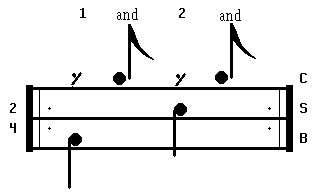
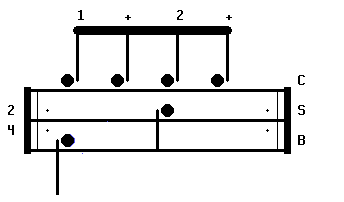
It would be easy to fill several books with variations of this style of playing. But, I'm not sure this would be the best way to progress. It seems the learning curve is greatly accelerated by simply jamming and improvising with this basic concept.
Begin with the basic Reggae (or Ska) pattern above, then try playing all of your routine 8th rock variations and syncs while maintaining this same somewhat spastic cymbal pattern.
I'll toss in a few 4/4 variations to get you started. You will quickly discover many more as you play along with your favorite Ska and Reggae recordings. Permutation theory will prove that 4.3 Billion possibilities exist here . . . it's the same as normal 8th rock. Give up on trying to learn them all. Just listen and jam with all your favorite music in this framework. The most important rhythmic possibilities should surface as you continue to listen and play music that falls within this genre'.
The following examples are written in 4/4.
A.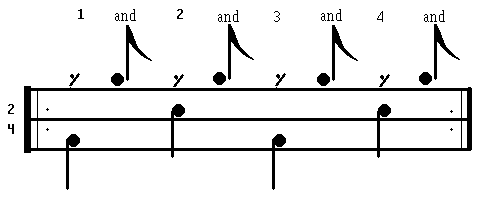
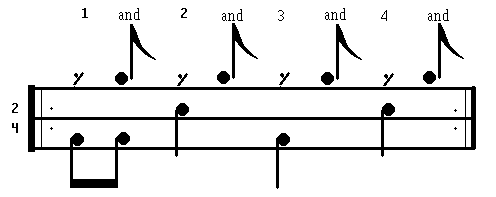
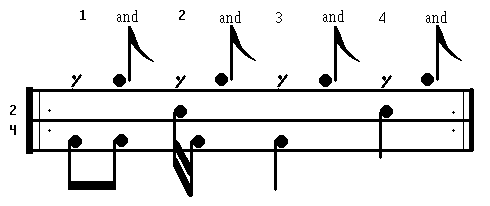
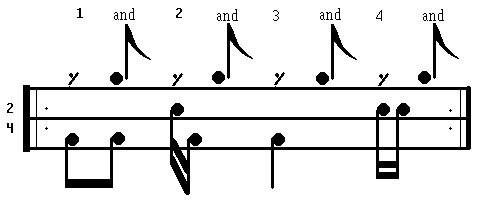
Video: For almost all handheld devices and other browsers.
You will need to 'live' and 'love' this music style to master playing it! Order up a new batch of Reggae or Ska recordings and get into it.
![]() Copyright Bill Powelson 1996-2008-2014 @ all rights reserved.
Copyright Bill Powelson 1996-2008-2014 @ all rights reserved.
![]() Drum Solo Video: Click to 'LEARN'
Drum Solo Video: Click to 'LEARN'
Watch and Learn Now! PLAY Great Drum Solos within hours (not years).
NEW 'Subliminal Method' teaches drum solo techniques PAINLESSLY!
Master rudiments 'NATURALLY' without boring regimentation or serious discipline.
Listen, watch and PLAY your way to awesome drum solos (and polished rudiments) BY SIMPLY HAVING FUN. . . . It works, folks!
Don't be a skeptic until you at least try it first.
![]()
![]()
7 EZ lessons to Rhythm-Guru Status.
E-mail support: (til I croak).
EZ Downloads to CDs/Flashdrives
Special Secret Seeds of Rhythm.
Breaking-into Career Drumming $$
Musical Time - Finite to Infinity: Learn to easily jam and play music comfortably within any odd or even time signature. This material isn't currently taught in music-theory classes, yet it is simple enough for grade-school students. Discover more than 18 quintillion unique and different (modern music) song-beat structures.
Discover the (lost) 500 year-old enigmatic secrets hidden within the current time-signature system. Seven short mesmerizing and easy-to-follow lessons will lead you quickly and easily towards (musical-time) guru status. You will learn to visualize (read, write or feel) the existence More . . .
This very informative little booklet will amaze you with hundreds of valuable tips and insider secrets!
HOW TO: Purchase old/used drumsets for pennies and resell them for decent profits. How to find the bargains, create thousands of attention getting finishes at low cost. Brighten old cymbals and learn to rebuild old drumsets from the gound up.